We are in the midst of a strong disruption in the IT sector and it is predicted that the global 2000 firms will spend 15–16 percent of their IT services on SMAC and the Indian IT sector is expected to export $15 billion worth of SMAC software and services!
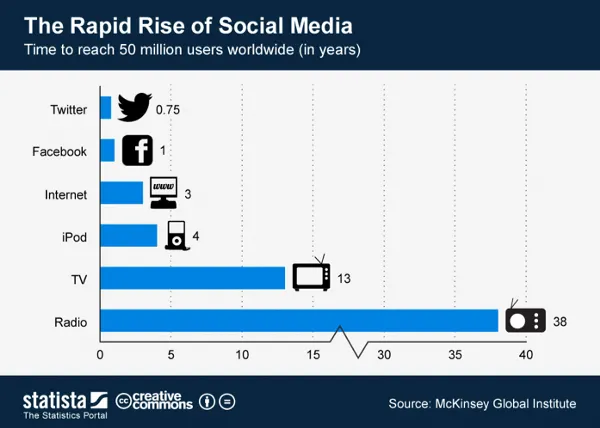
We have seen unprecedented adoption of social media. The rapid rise of social media as a communication medium is one of the main reasons why SMAC has become relevant in the last decade.
The term SMAC was coined by Malcolm Frank of Cognizant, in 2012. In 2013, Cognizant had over $500M revenue from SMAC, placing them in the lead of the pack of the IT industry. Cognizant employs more than 150,000 people in India, making them one of the largest IT sector employers here. In the world of Unicorns, we should note that they are a 30B$ behemoth capitalizing on the services opportunity using SMAC amo.
In order to understand SMAC and what it truly is, taking a tour on the history of computing is useful.
The Mainframe computer
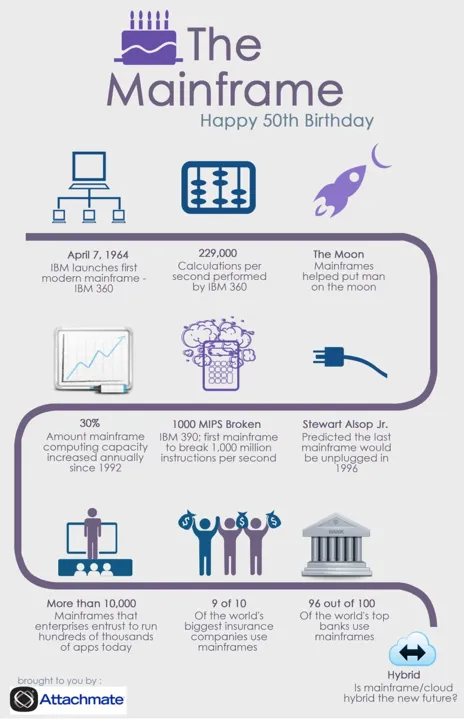
The first computing platform that changed the way organizations operated was the Mainframe computer. The time from the 1960’s till the end of the 1980’s and the introduction of the personal computer can be termed as the era of the Mainframe computer.
Like most computer technology innovations, the first to experience the impact and gain from it were enterprises. This also meant that the number of such computers sold were in the mere thousands, a far cry from the 47 Smartphones sold every second today.
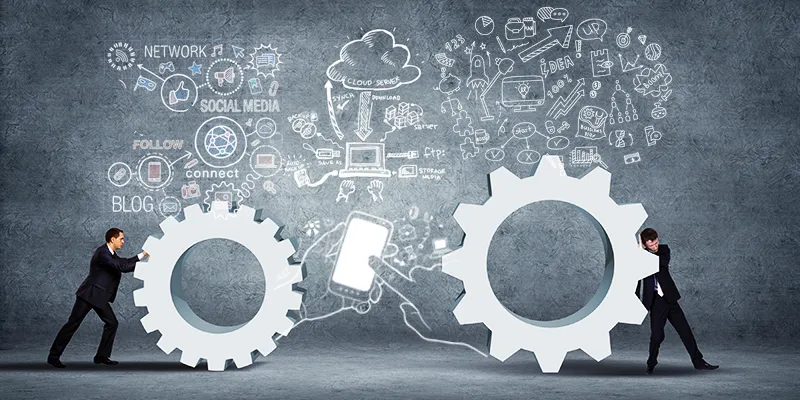
The impact of the mainframe has been manyfold from predicting weather to conquering space. This was recently highlighted in the biographical drama “Hidden Figures” which centres around the lives and contribution of the three women at NASA who solve critical problems using the IBM 7090 Mainframe computer, which enabled John Glenn to be the first American astronaut to orbit the earth.
Mainframes are still used today by several large banks, airline companies, and Fortune 1000 companies. It’s very likely that if you have done an ATM transaction, a mainframe is at the back-end of it.
Distributed Computing — The Personal Computer, The Internet and the World Wide Web

The Client/Server based platforms are the ones whose effect we feel to this day.
The origin of these platforms can be traced back to the work done on ARPANET in the late 60’s and, 70’s. It was the precursor to the internet which defined and implemented several of the protocols like TCP/IP which we use to this day.
The personal computing era saw the rise of companies like Microsoft and Apple, which transformed the way people thought about the integration of Hardware and Software, and made it possible for people to have their own computers! The transition from Centralized computing in the form of Mainframes to personal computers, followed by the Internet phenomenon, created a paradigm shift and the full impact of this convergence is something we are still experiencing with the Web 2.0, which is a term used to describe the transition from Websites going from static web pages to dynamic web pages with user generated content.
The internet and world wide web boom of the 90’s are now part of computing history.
This boom led to the formation of companies like Amazon, Salesforce, Paypal, Google, all of which captured a nascent opportunity of a market that is now sized in the several trillions.
The effect of these consumer and enterprise companies was felt through the first decade of the new millennium where businesses now had to learn a new delivery mechanism for products and new ways to reach their customers.
We in India too have benefited much from the rise of personal computing and Internet. The IT boom in India started from the Y2K opportunity, led by these new delivery models centred around outsourcing, and is now expected to reach an annual revenue of $350 Billion by the year 2025.
New models of communications, community and social interactions are creating the next wave in the digital era.
There were Social Networks aplenty that sprang up, from Orkut, MySpace, Friendster, and the most famous of them all Twitter, Facebook and LinkedIn. These social networks created online identities for people that went beyond their usernames and email ids. They were pioneers of user generated content to a curated audience.
The iPhone was launched during this decade, which was the first truly well-designed smartphone. It changed the way people thought about mobility and what could be done with a handheld device. What has followed has been a smartphone revolution that could not have been predicted.
The advent of so much data and so many ways for users to create data on the web led to the problem of ‘Big Data’.
The problem is simple, there is simply too much structured and unstructured data for organizations to handle on their own. While this data may be rich, it was not possible to derive insights out of it.
To solve this, companies like Cloudera and frameworks like Hadoop came up which led to the Analytics revolution. It is now almost mandatory for all companies with a web and mobile presence to use or build such tools to monitor their data and learn more about their users.
One of the marked differences between companies from the 1990’s and 2000’s was the development of the cloud.
Previously, if you needed to use internet enabled software, you would, download an application onto your personal computer, install it, have it connect to the web and then use your computer’s resources to do whatever was necessary with the software. While the term was initially used for marketing purposes only, which was the intention, it eventually led to a paradigm shift in how solutions were delivered.
The cloud changed all that.
Personal computers were just not powerful enough to do some of the operations that companies now had to do, they also couldn’t handle the amount of the data that was now necessary to be used by the software.
The cloud centralized a lot of these services and enabled businesses to access these solutions online by having cloud servers which would run independently of the user’s computer.
The user’s computer merely became a channel to access such tools. Salesforce is an example of a company that transitioned successfully into the world of the cloud.
The convergence of Social Networks (or Social Profiles), Internet enabled mobile computing, Analytics on big data, and delivery of software through the cloud is what we refer to as SMAC. We will explore this further in the next section.
When the consumer PC revolution happened, enterprises had to adapt to it and create solutions that catered to consumers that were distinct from the solutions that catered to businesses.
In many ways, this is what is going to happen in the SMAC revolution. The consumer is now the driver for enterprise change.
Let’s look at what such a platform looks like.
SMAC
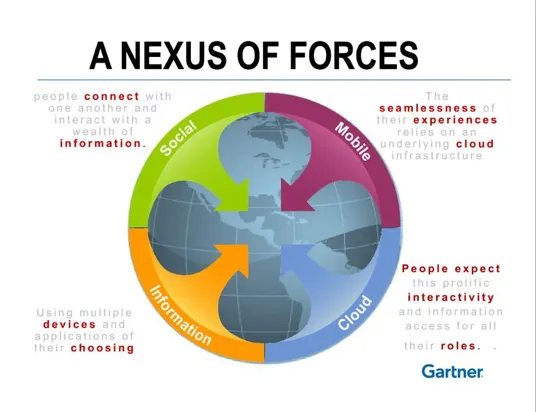
The International Data Corporation (IDC) calls it the third platform, Cognizant calls it SMAC and Gartner calls it the Nexus of Forces.
Whatever be the name, the next platform that enterprises will have to adapt to and move towards is definitely the one that lies at the intersection of Social, Mobile, Analytics and, Cloud. This sometimes includes IoT as well, but, for this discussion, we’ll use the term SMAC and focus on the 4 main parts of this.
Social — SMAC
Social refers to Social Networks and their importance in this day and age. The number of people on Social Media is constantly increasing and is at nearly one-third of the world’s population at this point. It is becoming the de facto standard for communication.
The growth is such that it cannot be ignored anymore, the rich data available on social platforms and the types of interactions that it enables makes it an undeniably powerful channel for communication and data for businesses.
The importance of the data available through these social networks will be discussed later.
Active Internet Users
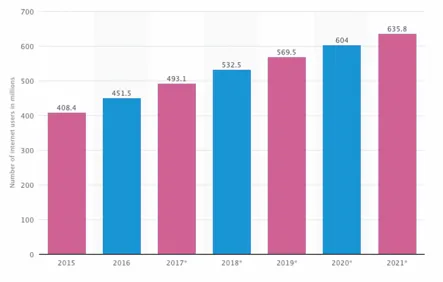
This statistic provides information on the number of internet users in India from 2015 to 2021. In 2016, India had 451.5 million internet users. This figure is projected to grow to 635.8 million internet users in 2021. Despite the untapped potential, India already is the second-largest online market worldwide.
Social Network Users in IndiaChart 6

In 2018, it is estimated that there will be around 283 million social network users in India, up from close to 216.5 million in 2016. The most popular social networks in India were YouTube and Facebook, followed by social app WhatsApp. Facebook is projected to reach close to 319 million users in in India by 2021.
India shares the characteristics of other global internet users in its passion for social media. In 2021, it is estimated that there will be around 358.2 million social network users in India, a significant increase from 2016, when this figure stood at about 216.5 million.
This means that the share of the Indian population that accesses social networks is expected to jump from around 16.3 percent in 2016 to just over 25 percent.
Mobile— SMAC
The number of mobile connections worldwide is expected to cross the number of people in the world and as we have covered in a previous report — ‘India Macro and Consumption’ ,the number of smartphones with powerful data connections is expected to grow at a significant rate over the next 2 years.
The impact of mobile will be similar but, further reaching than the impact of the personal computer. The mobile offers far more convenience and a better user experience, while all the while, being ‘mobile’.
Most of the people coming onto the internet from now on can be expected to be mobile first and maybe mobile only. The ratio of mobile users to PC users is now 4:1.
What this means for businesses is that the demographics of the customers being catered to are going to significantly change over the next few years and they have to be ready to adapt to it.
This change is already very visible to everyone in India, where the impact of the convergence of social and mobile itself is best shown by the fact that India is the fastest growing market for social networks like Instagram, Facebook, Snapchat; messaging apps like Whatsapp, and even for video consumption, through platforms for YouTube, Netflix and the homegrown Hotstar.
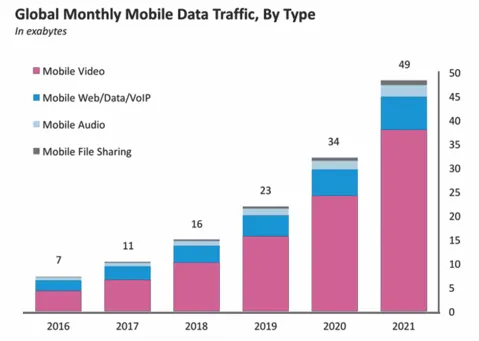
Mobile data will skyrocket 700% by 2021
Day to day mobile usage for mobile e-commerce and mobile social media engagement including chat, voice or video calls, and mobile video has the highest growth rate among the mobile content categories. This is unsurprising, as over half of global digital video consumption during the fourth quarter of 2016 was via mobile device.
Rise of India as an App Superpower
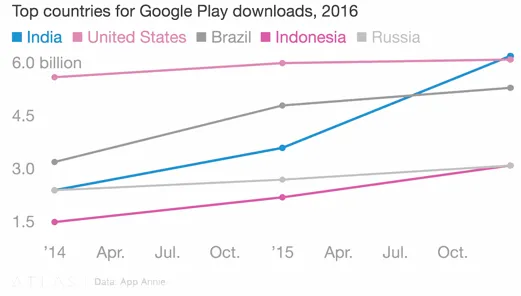
Growth Drivers fuelling the App Market:
- Growing Mobile Internet Penetration — Internet Plans < $1/GB
- Cheaper smartphones — 100+ smartphone models for < $100
- Mobile-ready regional content
In 2016, India surpassed other countries in terms of number of App downloads. Growing at CAGR of 26%, number of annual App downloads in India is expected to touch 20 billion by 2020.
Analytics — SMAC
With the incredible amount of data flowing through the various social networks and through mobile phones, came the problem and opportunity of handling Big Data. The work on big data has led to what can now be considered a mainstay for all products, Big Data Analytics. No business can, on its own, handle the amount and type of data that comes to it these days.
It is estimated that on average, 2.5 quintillion bytes of data are generated every day, a number that continues to grow. This presents a problem for business simply because it is important to make sense of the data that is being collected.
Businesses today have to take advantage and adapt to advances in analytics to make sense of the large amount of unstructured data flowing their way in order to recognize patterns, personalize experiences, etc.
The convergence of Analytics and Social will lead to better personalization of user preferences based on their activity on various social platforms. The convergence of Analytics and Mobile will allow business to better understand the users who more often than not will be coming to them on mobile first.
The need to derive predictive and actionable insights from this data for improved business operations and better decision making is what drives Big Data analytics.
Opportunities for Indian players
- Capitalising on its already well established IT/BPO and knowledge service outsourcing industry, India is rising to play an important role as a key outsourcing destination in the overall Big Data landscape for services relating to Big Data technology, implementation, and analytics
- India‘s domestic Big Data market is at a nascent stage, hence offering outsourcing services holds the key for Indian enterprises
Although immense amount of data is being generated across all industry verticals including financial services, manufacturing, retail, healthcare, telecom, logistics, and others, financial services and telecom are early adopters of Big Data technologies.
Cloud — SMAC
Cloud in general refers to the ability to access a particular service through a provider from anywhere using the web — made possible through a combination of the internet, continuation of Moore’s law and the reliability of networks.
This has led to the ability to deliver quality services that work on large amounts of data stored in remote locations to clients.
The advent of the cloud has led to new innovative business models that developed in the age of the Client/Server platform.
The delivery of computing services over the internet that allow people and enterprises to use hardware and software, are managed by third parties at a remote location. This is Cloud computing! It provides a shared pool of resources including data storage space, networks, computer processing power & specialized corporate/user applications.
Demand-side growth drivers
- Greater economic volatility driving need for dynamic and flexible IT
- Hypercompetitive market driving need for accelerated time to market
- Increasing reliance on technology to drive differentiation in offerings
Supply-side growth drivers
- Maturing and increasingly affordable virtualization technologies
- Improving communication infrastructure
- Increasing standardisation of workloads
Factors driving migration to Clouds
- The complexity and the cost of owning networks and operating computers is reduced by cloud. This is due to cloud users not having to invest in IT infrastructure, buying software licenses or purchasing hardware
- The benefits are low up-front costs, rapid return on investment, rapid deployment, customization, flexible use and solutions that can make use of new innovations in processes, products & services
- Other benefits to users include scalability, reliability, and efficiency
As per a survey by KPMG, 59 percent of providers say that cost reduction is the customers’ main reason for using cloud.
Why is the advent of the SMAC platform important?
According to Gartner, cloud services spending in India will reach $4.2 billion this year. SaaS itself will grow to $572 million this year.
SMAC platforms are important and in many ways, inevitable, because:
- Most people in the world will be on social networks
- Most people in the world will be mobile first/mobile only
- To make sense of the massive amount of data flowing in is impossible for any business by itself. Hence, the need for analytics
- The ability to access anything, anywhere through the cloud will be a necessity
For large businesses, if adapting and orienting their business practices and models to SMAC is not on the roadmap in the near future, they run the risk of being overrun by smaller players who are far more nimble and capable of adapting to such a change.
In India, Global services companies like TCS, HCL, Wipro and Cognizant are very aware of the incoming revolution and have begun taking steps to adapt to this.
Companies across the board, not just in technology, should take steps to incorporating levels of the SMAC stack into their business.
Netflix is one of the best examples of a company that has taken advantage of SMAC to disrupt an entire industry.
Currently Netflix has more subscribers in the US than there are cable connections.
Netflix leverages Social data to provide recommendations to users, runs recommendations on its own data by using analytics, allows its users to stream content through the cloud and is available on mobile.
On top of all this, it allows users to choose what they want to watch, when they want to watch it. Cable companies and channels were just not ready for this, and the effect of this can be seen in their stock price.
While such disruption might still take time to happen in India, changes are visible: Netflix has entered India and in competing with homegrown Hotstar for the same mind space.
There is no clear prediction of how much this disruption will affect each industry from a displacement of incumbents. What can be said however is that, it is best if you disrupt yourself using the power of SMAC, otherwise someone else will.
As a venture capital firm, we believe SMAC has a plethora of opportunities to be unfolded for entrepreneurs. We are actively looking to invest in this space. We think it can be a space that could be attractive to venture funding in India alone. While, so far we don’t have many notably product companies that have emerged from India, we think SMAC has the potential to change that.
Several interesting companies are blooming in this space globally, including the likes of Hootsuite, Sprinklr & Sprout Social; and Crowdfire from India
Acknowledging Anuj Mehta & Sainath Rajagopal, contributors to this article. Anuj & Sainath are Kstart fellows.
Note — Kalaari is an investor in Crowdfire. Kalaari or Kstart is not an investor in any other startups that may have been mentioned above.
Disclaimer : It is strictly an independent opinion of the writer, not representative of Kstart or Kalaari.
(Disclaimer: The views and opinions expressed in this article are those of the author and do not necessarily reflect the views of YourStory.)







